






KLETT WORLD LANGUAGES is a publishing house specializing in print and digital instructional materials for learning and teaching world languages.
Our mission is to help students become global citizens by developing their intercultural and critical thinking skills through language learning. We aim to help students learn and use language in real-life situations by creating engaging and meaningful content that sparks their curiosity and motivates them to learn.
We strongly believe that teachers play a key role in language learning, and part of our mission is to support them and to provide ample opportunity for professional development.
Having them is not enough. We live by them.
Because everyone on the core KWL team has a background in education and works closely with educators and students, our commitment goes far beyond our daily work. We understand the needs of educators and students and we are passionate about looking for solutions and tools to help them succeed.
We are committed to providing high-quality print and digital content at affordable prices to all who want to learn a language. We guarantee lower prices for high-quality content and simple, easy-to-use technology.
We view languages as tools for communication and action. To learn a language and build authentic communicative competency, students need a realistic context, a true need to communicate, a focus on meaning, and the right linguistic resources. That is what we provide in our educational materials.
Our educational materials focus on the most current pedagogical methodology. They follow the ACTFL Guidelines for Proficiency, include Can-Do statements, and address the 5 Cs. Our digital resources provide original and authentic content via a simple and easy-to-use platform.
We see educators as our partners, and the core of our mission is to support them by providing professional development opportunities, highquality documents and activities, and instructor resources in an easily accessible format.
Our content is created to help students use language to communicate and interact with other communities and cultures both in the United States and abroad. Our books present a respectful, modern, and open-minded perspective of our world and its cultures that allows students to dismantle stereotypes and to cultivate an awareness of global concerns.

Communication
Introducing yourself and others | spelling | asking for someone’s telephone number and age | greetings and saying goodbye
Vocabulary
Numbers from 0 to 20
Communication
Talking about school Vocabulary School supplies | numbers up to 100
Grammar
Singular personal pronouns: ich, du, er, sie | verbs: sein and heißen | W-questions
Pronunciation
The alphabet Mehr üben
Grammar
Nominative definite articles: der, das, die | plural | verb forms: du lernst, du hast … | Yes-/Noquestions | plural personal pronoun: sie | mein and dein Pronunciation
Intonation: Yes-/No-questions and statements

Communication
Where people are from Vocabulary
Grammar
Communication
Reading and writing a profile | understanding and conducting an interview
Vocabulary Professions | free time activities
Grammar
Woher? – aus | verb: kommen | indefinite articles in the nominative: ein/eine | negation with kein/ keine | Wo? – in Pronunciation
Grammar
Negating with nicht | modal verb: können | plural personal pronouns: wir, ihr, Sie
Pronunciation st and scht Mehr

Communication
Talking about your daily routine | writing about a dream day/horrible day
Vocabulary
Times of the day | telling time
Grammar
Wann? – am Nachmittag | Wann? –um sieben | verb in 2nd position | separable verbs | zuerst, dann, danach
Pronunciation
Word stress: separable verbs
Mehr üben … 70
Communication
Talking about school schedules | talking about your school Vocabulary
Days of the week | school subjects | after school activities
7 Kommst du mit?
Kommunikation
Saying what you want and what you have to do | setting up a date | talking about hobbies | making and understanding requests Vocabulary
Hobbies
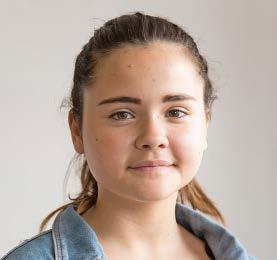
Communication
Talking about your own language | talking about getting to school Vocabulary
Languages | means of transportation
Grammar
Wann? – am Montag | verb: haben | sein + adjective | gern | verbs with a stem-vowel change | unser and euer
Pronunciation
Long and short vowels
Mehr üben … 82
88
Grammar
Modal verbs: wollen and müssen | du-imperative
Pronunciation
Intonation: imperatives
Mehr üben … 94
100
Grammar
Pronoun: man | verb: sprechen | sentences with deshalb | mit + dative | sein, ihr
Pronunciation
ü or u? – ö or o?
Mehr üben … 106
Training B 112
Grammar summary | A horrible day | The island game
Mehr üben: Vocabulary: Understanding the glossary | Vocabulary: Making flash cards
Communication
Saying what one always/often/ sometimes/never does | talking about music | saying that you find something to be great
Vocabulary
Activities with friends
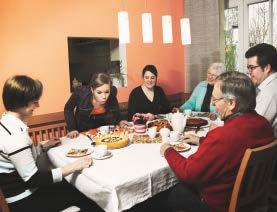

Communication
Talking about birthdays | congratulating
Vocabulary
Months | seasons | family | pets
Grammar
Sentences with aber | accusative verbs | definite articles in the accusative: den, das, die
Pronunciation
Sentence stress
Mehr üben … 126
Grammar
Indefinite articles in the accusative: (k)einen, (k)ein, (k)eine | lieber
Pronunciation
-er at the end of the word Mehr üben … 138
Communication
Asking about prices | ordering something | saying what you like or don’t like to eat
Vocabulary
Shops | food | measurements
Grammar
Verbs: mögen and brauchen | für + accusative
Pronunciation
p – b, t – d, k – g
Mehr üben … 150
Communication
Understanding a program | talking about clothing | telling a story
Vocabulary
Colors | clothing
Grammar
Dative verbs | personal pronouns in the dative: mir, dir | questions with welcher, welches, welche
Pronunciation
eu – au
Mehr üben … 162
Grammar summary | Exchange partners | Bulletin board
Mehr üben: Grammar: Mnemonic sentences | Grammar: Forming sentences

Communication
Talking about vacation | describing the way to a destination | writing messages from vacation
Vocabulary
Grammar
Wohin? – nach Italien, zu meiner Oma, an den See, in die Berge | Wohin? – in + accusative, zu + dative | es | preterite: war, hatte
Pronunciation
s – ss – ß – sch
Mehr üben …
Travel destinations | in the city | weather 14 Gute Besserung! 188
Communication
Talking about illnesses | telling a story | talking about exercise
Vocabulary
Body parts | aches and pains 15
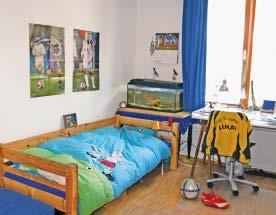
16 Finale

Communication
Giving directions | responding to an invitation | describing a ride on a commuter train | describing a housing situation
Vocabulary
My room | rooms
182
Review game
Grammar and vocabulary review
Festivals and celebrations in D - A - CH
Interesting cultural aspects of Germany, Austria and Switzerland
Grammar summary | An active vacation | Regions in Germany
Grammar
Genitive -s with proper names | personal pronouns in the accusative: mich, dich, …
Pronunciation
Pronouncing difficult words
Mehr üben … 194
Grammar
Wo? – in + dative | ihr-imperative | Wo? – bei meinen Eltern, am See, im Park, auf der Weide
Pronunciation
With or without h?
Mehr üben … 206
212
The graduation party
Throwing a graduation party
Mehr üben … 218
Mehr üben: Speaking: Inquiring | Speaking: Explaining words | Speaking: Explaining words using gestures
Appendix Glossary 232 | Alphabetized Glossary German-English 258 | Alphabetized Glossary English-German 272 | Thematic word groups 287 | Irregular and separable Verbs 289 | German in class 290 | Credits 291
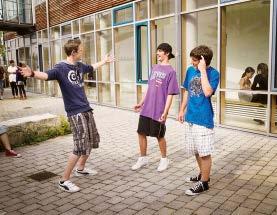
Expressing doubt | understanding a letter | expressing assumptions
Vocabulary
Leisure time activities | times in the daily schedule | four compass points
Grammar gern, lieber, am liebsten | present perfect (I): regular verbs
Talking about school | saying that you didn’t understand something Vocabulary School | preferences

Talking about problems | giving advice | making plans | understanding public announcements and voice mails
Present perfect (II): irregular verbs | Welch-? in the accusative | mein, dein, ... in the accusative
weak
Grammar würde + infinitive | present perfect (III): separable and inseparable verbs | sentences with wenn | Wo? – Vor ...
Communication
Making excuses | sequencing | saying that you don’t understand something Vocabulary Means of transportation | zuerst, danach, dann, anschließend …
Grammar
Modal verbs in the preterite: wollte, konnte, musste
Pronunciation
of final consonant
Grammar summary | A german tradition | On the Rhine Mehr üben: Speaking training: Asking and answering about a topic | Speaking training: Reporting about an experience | Workshop Deutsch: Explaining something
5

6 Kleidung und



Communication
Talking about sports | describing people | writing short messages
Vocabulary
Sports activities | attributes of people

7 Freundschaften
Communication
Talking about pictures | asking about and saying prices | expressing opinions
Vocabulary
Clothing | colors
8 Familienfeste
Communication
Expressing feelings | planning meeting places | talking about friendship
Vocabulary
Setting a time
Communication
Talking about festivals | reacting to an invitation | expressing happiness and anger
Vocabulary
eating and drinking | dates and ordinal numbers
Grammar
Sentences with weil | comparisons: schneller als, so schnell wie | superlative: am schnellsten
Pronunciation
pf and ts
Mehr üben … 70
76
Grammar
Adjectives (I) with the definite article: der blaue Pullover, den blauen Pullover
Pronunciation
au and eu
Mehr üben …
82
88
Grammar
Adjectives (II) with the indefinite article: ein arroganter Typ, einen großen Fehler | past tense questions
Pronunciation
Ich- and ach-sound
Mehr üben …
94
100
Grammar
dative definite articles: dem, der, den | reflexive verbs: sich freuen
Pronunciation
weak e and weak a Mehr üben …
Grammar summary | Soccer fans in Germany | Stars and celebrities Mehr üben: Speaking training: Planning something together | Workshop Deutsch: Introducing a celebrity
106
112

Communication
Talking about money | paraphrasing words | describing favorite things
Vocabulary
Personal items
Communication
Describing rooms and places | expressing wishes: … hätte gern …
Vocabulary
Furniture | legen, stellen, hängen …
Grammar
Sentences with dass | dieser, diese, dieses in the nominative and accusative | ein, eine in the dative | mein, dein ... in the dative
Pronunciation
-r- and -er
Mehr üben …
126
Grammar
Two-way prepositions: auf den Tisch stellen, auf dem Tisch stehen | indirect questions
Pronunciation b or w
Mehr üben … 138

Communication
Talking about cities | understanding forms | giving directions
Vocabulary
Numbers up to one million | years | places in the city
Grammar
Modal verb: dürfen, nicht dürfen | adjectives in the dative | sentences with denn
Pronunciation
A small difference: m and n
Mehr üben … 150
Communication
Expressing feelings | Expressing preferences and reluctances | understanding news | writing a story
Vocabulary
Activities in nature | weather
Grammar
sondern | deshalb/darum and trotzdem | comparisons with als and wie
Pronunciation
Word stress (I)
Mehr üben … 162
Grammar summary | A class outing | Am größten, am höchsten, … Mehr üben: Speaking training: Describing a room | Speaking training: Reporting about an experience | Workshop Deutsch: Giving directions | Workshop Deutsch: Describing a location

Communication
Describing appearances and changes | recounting an accident | criticizing others
Vocabulary
Doctor’s visit | illness and injury
Grammar
Main clauses with conjunctions | Subordinate clauses with dass, weil, wenn | modal verb: sollen
Pronunciation
Word stress (II)
Mehr üben … 182
Communication
Talking about media | politely asking or requesting something of someone | understanding advertisements
Vocabulary
Grammar
modal verbs in the preterite: durfte, musste, ... | verbs with the dative and accusative: Ich gebe dir einen Tipp.
Pronunciation
Stress in requests
Communication and entertainment media | dates and years 15 Nach der Schule 200
Communication
Talking about professions | expressing career wishes | understanding a radio report
Vocabulary
Mehr üben … 194
Grammar
Time expressions with prepositions | werden as main verb | also | expressions of place with prepositions
Pronunciation
Sentence intonation
Professions 16 Finale 212

Review game
Reviewing grammar and vocabulary
A school year in D - A - CH Exchange students in Germany, Austria and Switzerland
Grammar summary | MINT | The bike tour
Mehr üben … 206
Our class newspaper
Writing a school newspaper
Mehr üben … 218
Mehr üben: Speaking training: Giving a short presentation | Speaking training: Giving feedback after the presentation | Workshop Deutsch: Summarizing a presentation
Appendix Glossary 232 | Alphabetized glossary German-English 258 | Alphabetized glossary English-German 272 | Thematic word groups 288 | Irregular verbs 290 German in class 291 | Credits 292
sieben
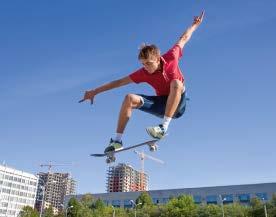
about leisure time | making suggestions | expressing
Grammar
Subordinate clause before main clause | subjunctive II: würde, hätte | separable verbs in subordinate clauses | verbs with prepositions
Pronunciation
Sentence intonation
Talking about new classmates | making recommendations: Er sollte … | reading a blog
exchange | family
Discussing places to live | agreeing and disagreeing Vocabulary Types of housing

Talking about interests | giving directions | comparing | complaining
Grammar
Relative clauses in the nominative and accusative | subjunctive II: sollte and wäre | unreal sentences with wenn
Pronunciation
ä, ö, ü
Grammar
Indefinite numerals: alle, viele … | relative clauses with wo | indefinite pronouns: irgendwer, irgendein …
Pronunciation
Pronouncing difficult words Mehr üben … 48
Grammar
Genitive with definite and indefinite articles | infinitive with zu
Pronunciation
Grammar summary | Planning a presentation | Geocaching on Wangerooge, Rügen, at the Brocken and in Saxon Switzerland
Mehr üben: Listening training: UNESCO-World Heritage Site, A hike through the sea | Workshop Deutsch: Passing on information
5 Das ist mir wichtig.
Activities
Expressing one’s opinion I writing a commentary I presenting a book
Vocabulary
Fashion and clothes | qualities
Grammar
Review: adjective endings I adjective endings in the comparative and superlative: die bessere Note, das beste Lied
Pronunciation
Equal consonants at the word boundary
Mehr üben …
88
6 Kommunikation 96

7 Geschichte(n)

Activities
Expressing assumptions | describing something | expressing yourself appropriately | understanding abbreviations in chats and text
messages | addressing someone
Vocabulary
Chat language | project work
Grammar
Relative clauses with prepositions | preterite (I): regular verbs
Pronunciation
Many consonants
Mehr üben …
104
Activities
Talking about the past | telling and writing a story
Vocabulary
cinema | seafaring
8 So ist das bei uns.
Activities
Giving tips for an invitation | preparing and conducting interviews | talking about scenes | talking about languages
Vocabulary
Scenes | moods | languages
Training B
112
Grammar
Preterite (II): irregular verbs | sentences with als | sentences with bis
Pronunciation
Long and short vowels
Mehr üben …
120
128
Grammar
Sentences with obwohl and weil | noun-verb constructions
Pronunciation
st and sp
Mehr üben …
136
144
Grammar summary | Writing a formal e-mail | Palaces and castles in Germany, Austria and Switzerland
Mehr üben: Reading training: Spectacular scenes | Workshop Deutsch: Sets in Germany, Austria, Switzerland
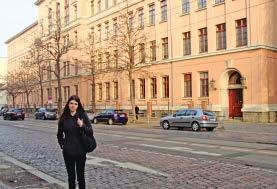
Activities
Giving tips on how to study | understanding an informational text | expressing an opinion about school
Vocabulary
School | food | animals
10 Natur und Umwelt
Activities
Expressing beliefs | giving tips about the environment
Vocabulary
Weather | climate | environment

Activities
Talking about work and job training | expressing a sequence | describing a profession
Vocabulary
Job training | professional activities
Grammar
Activities
Describing feelings | talking about friendship | making an appointment or date
Vocabulary
Friendship | love | modal particles
152
Past perfect tense: er hatte gelernt | sentences with nachdem | preterite (III): separable verbs
Pronunciation
Vowel at the beginning of a word
Mehr üben … 160
168
Grammar
Prepositions with the genitive (I): wegen, trotz | nouns with the ending -(e)n | sentences with damit and um … zu
Pronunciation
Final devoicing
Mehr üben … 176
184
Grammar
Sentences with so …, dass / sodass | question words with prepositions: wovon, worauf … | adjectives without an article | simple future: er wird arbeiten
Pronunciation
Intonation in oder-questions
Mehr üben … 192
200
Grammar
Sentences with als and wenn in the past tense | indirect Yes-/Noquestions: ob | demonstrative articles: derselbe, denselben
Pronunciation
Modal particles
Mehr üben … 208
216
Grammar summary | A cultural comparison | Figures and facts about Germany, Austria and Switzerland
Mehr üben: Writing training: Typical teens in Germany, Austria and Switzerland, Saliah’s text on pocket money | Workshop Deutsch: Typicals teens in our country

Inquiring | understanding information in public transportation | ordering in restaurants
Vocabulary
Travel | restaurant
Understanding announcements | talking about consumerism | asking for information in stores
Vocabulary
Consumerism | stores

Activities
Talking about things you like | agreeing about something | describing a movie
Vocabulary
Music | movies
Review game
Reviewing grammar and vocabulary
A trip through Germany, Austria and Switzerland
Knowing destinations in Germany, Austria and Switzerland | planning a trip
Grammar
Parenthetic relative clauses | passive present: Das Gepäck wird kontrolliert. | während + genitive
Pronunciation n – ng – nk
Mehr üben … 232
Grammar
da(r) + preposition | position of pronouns: Ich kaufe es mir. | infinitive as a request: Bitte lächeln!
Pronunciation h at the beginning of words and syllables
Mehr üben … 248
Grammar
Passive preterite: es wurde gekauft | sentences with bevor, seit, während | review: subordinate clauses
Pronunciation
International words
Mehr üben … 264
Progress
A trip through Portfolio Deutsch NEU | the friends in 10 years
German-Stations
Preparing learning stations together
Mehr üben …
Grammar summary | Space | Inventions in Germany, Austria and Switzerland
Mehr üben: Speaking training: Mensch, ärgere dich nicht!, Tell me how to play, The history of the game | Workshop Deutsch: Games we play
Appendix Glossary 296 | Alphabetized glossary German-English 332 | Alphabetized glossary English-German 351 | Irregular verbs 373 | Credits 375 sieben
280



To explore and download these
please visit klettwl.com/state-specific-support
LEVEL: NOVICE LOW TO NOVICE HIGH
ACTFL World-Readiness Standards

Communicate effectively in more than one language in order to function in a variety of situations and for multiple purposes
Interpersonal Communication: Learners interact and negotiate meaning in spoken, signed, or written conversations to share information, reactions, feelings, and opinions.
UNIT 1: p. 8 (act. 2a, 2b), p. 9 (act. 3b, 3c, 5b, 5c, 6), p. 10 (act. 7b, 8a, 8b, 9b, 10), p. 11 (act. 11b, 12, 14a, 14b, 15a, 15b), p. 14 (act. 3a, 3b), p. 15 (act. 5a, 5b, 7), p. 16 (act. 8, 11a), p. 17 (act. 11b, 12, 15b), p. 18 (act. 16b), p. 19 (act. 18, 21)
UNIT 2: p. 20 (act. 1a), p. 21 (act. 3a, 3b, 4a, 4b, 5), p. 22 (act. 6d, 8), p. 23 (act. 9b, 10a, 10b), p. 24 (act. 11, 12c, 13c), p. 26 (act. 3a, 3b), p. 27 (act. 4a, 4b, 5a, 5b), p. 28 (act. 6, 8a, 8b), p. 29 (act. 9b, 10), p. 30 (act. 12b), p. 31 (act. 18)
UNIT 3: p. 32 (act. 1a, 1c, 1d, 1e), p. 33 (act. 2, 3, 4), p. 34 (act. 5, 6, 7a, 7b), p. 35 (act. 9), p. 36 (act. 11b, 12, 14), p. 38 (act. 1b, 2), p. 39 (3a, 3b, 4, 5, 6), p. 40 (act. 7a, 7b, 8b), p. 41 (act. 9, 10, 11), p. 42 (act. 12, 13a, 13b, 14), p. 43 (act. 15, 17, 18)
UNIT 4: p. 45 (act. 2), p. 45 (act. 3b, 4a, 4b, 4c), p. 46 (act. 6b, 7), p. 47 (act. 8a, 8b, 8c, 8d, 9a, 9b), p. 48 (act. 12a, 12b, 13b), p. 50 (act. 1b), p. 51 (act. 4b, 4c, 4d), p. 52 (act. 6, 7, 8a, 8b), p. 53 (act. 9, 10a, 10b, 11b), p. 54 (act. 12b), p. 55 (act. 14, 17)
UNIT 5: p. 64 (act. 1b), p. 65 (act. 2a, 2c, 3a, 3b), p. 66 (act. 5b),p. 67 (act. 6, 7b, 8a, 8b), p. 68 (act. 9a, 9d, 9e, 10), p. 70 (act. 2, 3, 4a, 4b), p. 71 (act. 4c, 5b), p. 72 (act. 7a, 8), p. 73 (act. 9a, 9b, 10a, 10b), p. 74 (act. 11), p. 75 (act. 12, 13, 14, 15)
UNIT 6: p. 76 (act. 1, 2), p. 77 (act. 3b, 4, 5a, 5b, 6), p. 78 (act. 8), p. 79 (act. 9a, 9b, 10b, 11a, 11b), p. 80 (act. 12b), p. 82 (act. 2), p. 83 (act. 4a, 4b, 5a, 5b, 5c), p. 84 (act. 7a, 7b, 7c), p. 85 (act. 8, 9, 10a, 10b), p. 86 (act. 11, 12), p. 87 (act. 14, 17)
UNIT 7: p. 89 (act. 2a, 3), p. 90 (act. 5a, 5b, 6, 7, 8), p. 91 (act. 9, 10a, 10b, 12a, 12b), p. 92 (act. 13a, 13c, 13d, 14a, 14b, 14c), p. 94 (act. 1, 3a), p. 95 (act. 3b, 4a, 4b), p. 96 (act. 6a, 6b, 7, 8, 9a), p. 97 (act. 9b, 10), p. 98 (act. 13a, 13b, 13c, 14a, 14b), p. 99 (act. 15, 16, 17, 18)
UNIT 8: p. 100 (act. 1a, 1b, 1c), p. 101 (act. 3a, 3b), p. 102 (act. 4b, 4c), p. 103 (act. 5a, 5b, 6a, 6b, 6c), p. 104 (act. 7a, 7b, 7c, 8), p. 106 (act. 1a, 1b, 1c), p. 107 (act. 2b, 3a, 3b), p. 108 (act. 4a, 4b, 4c, 4d), p. 109 (act. 5a, 5b, 5c, 6), p. 110 (act. 7a, 7b, 7c, 8), p. 111 (act. 9, 10, 11, 12)
UNIT 9: p. 120 (act. 1a, 1d), p. 121 (act. 2b, 3, 4), p. 122 (act. 5a, 5b, 5c, 5d), p. 123 (act. 6a, 6b, 6c, 7b), p. 124 (act. 8a, 8b, 9b, 9c), p. 126 (act. 2a, 2b), p. 127 (act. 3a, 3b, 4b), p. 128 (act. 5a, 5b, 6a), p. 129 (act. 6b, 6c, 7), p. 130 (act. 8, 9b), p. 131 (act. 10, 11, 12, 13)
UNIT 10: p. 132 (act. 1b, 1c), p. 133 (act. 2b, 3a, 3b, 4a, 4b), p. 134 (act. 5a, 5b, 7a, 7b, 7c), p. 135 (act. 8b, 8c, 8d), p. 136 (act. 9a, 9b, 10a, 11), p. 138 (act. 1a, 1b, 1c, 2), p. 139 (act. 3, 4), p. 140 (act. 6, 7a, 7b, 7c), p. 141 (act. 8a, 8b, 8c, 8d), p. 142 (act. 9a, 9b, 11), p. 143 (act. 12a, 12b, 13a, 13b, 14)
UNIT 11: p. 144 (act. 1a, 1d), p. 145 (act. 2b, 2c, 3a, 3b, 3c), p. 146 (act. 4b, 5a, 5b), p. 147 (act. 6a, 6c, 7a, 7b, 7c, 9), p. 148 (act. 10b), p. 150 (act. 1a, 1b, 1c, 2b), p. 151 (act. 3a, 3b, 4a, 4b), p. 152 (act. 5a, 5b, 6b), p. 153 (act. 7), p. 154 (act. 9a, 9b, 9c, 9d, 10a, 10b), p. 155 (act. 11a, 11b, 13, 14)
UNIT 12: p. 156 (act. 2a, 2b), p. 157 (act. 3b, 3c, 3d), p. 158 (act. 4c, 5b), p. 159 (act. 6b, 7), p. 160 (act. 8), p. 163 (act. 3b, 3c), p. 164 (act. 5a), p. 165 (act. 6b), p. 166 (act. 8a, 8b), p. 167 (act. 10c)
UNIT 13: p. 176 (act. 1b, 2a), p. 177 (act. 3a, 3b, 4a, 4b, 5), p. 178 (act. 6b, 6c, 7b), p. 179 (act. 8b), p. 180 (act. 9b, 10a, 10b), p. 182 (act. 1a, 1b, 1c, 2a, 2b), p. 183 (act. 3, 4b), p. 184 (act. 6, 7a, 7b, 7c), p. 185 (act. 8a, 8b, 9a, 9b), p. 186 (act. 9c, 10a, 10b, 10c, 10d, 10e), p. 187 (act. 11, 12, 13, 14)
UNIT 14: p. 188 (act. 1b, 2), p. 189 (act. 3c, 4a, 4b), p. 190 (act. 5a, 5c), p. 191 (act. 6a, 6c), p. 192 (act. 7a, 7b, 7c), p. 194 (act. 1a, 1b, 1c), p. 195 (act. 2a, 2b, 2c, 3, 4), p. 196 (act. 5a, 5b, 5c), p. 197 (act. 6a, 6b, 6c, 6d), p. 198 (act. 7, 8c), p. 199 (act. 10, 11, 12)
Interpersonal Communication: Learners interact and negotiate meaning in spoken, signed, or written conversations to share information, reactions, feelings, and opinions.
UNIT 15: p. 200 (act. 1a, 2), p. 201 (act. 3a, 3b, 3c), p. 202 (act. 4c, 4d, 5b), p. 203 (act. 6b, 7a, 7b, 7c), p. 204 (act. 8a, 8c), p. 206 (act. 1a, 1b, 2a, 2b), p. 207 (act. 3a, 3b, 3c, 3d), p. 208 (act. 4a, 4b, 4d), p. 209 (act. 5a, 5b, 5c, 6a, 6b), p. 210 (act. 7a, 7b, 8a, 8b, 8c), p. 211 (act. 10a, 10b, 11, 12, 13)
UNIT 16: pp. 212-213 (act. 1), p. 214 (act. 2a, 2b), p. 215 (act. 2d), p. 216 (act. 3a), p. 217 (act. 3b, 3c, 3d, 3e), pp. 218-219 (act. 1), p. 220 (act. 2a, 2b), p. 221 (act. 2c, 2d), p. 222 (act. 3a, 3b, 3c, 3d), p. 223 (act. 3e, 3f, 3g, 3h)
Interpretive Communication: Learners understand, interpret, and analyze what is heard, read, or viewed on a variety of topics.
UNIT 1: p. 8 (act. 1a, 1b, 2a), p. 9 (act. 3a, 3c, 4, 5a), p. 10 (act. 7a, 7b, 8a, 9a, 9b), p. 11 (act. 11a, 13, 14a, 15a), p. 12 (act. 16a, 16b, 16c), p. 14 (act. 1, 2), p. 15 (act. 4, 6), p. 16 (act. 8, 9a, 9b, 10), p. 17 (act. 11b, 12, 13, 14, 15a), p. 18 (act. 16a, 16b, 17), p. 19 (act. 19, 20)
UNIT 2: p. 20 (act. 1a, 1b, 2a, 2b), p. 21 (act. 4a), p. 22 (act. 6a, 6b, 6c, 7a, 7b, 8), p. 23 (act. 9a, 9b, 10a), p. 24 (act. 12a, 12b, 13a, 13b), p. 26 (act. 1, 2), p. 27 (act. 4a), p. 28 (act. 7, 8a, 8b, 9a), p. 30 (act. 11, 12a, 13), p. 31 (act. 15a, 15b, 16, 17)
UNIT 3: p. 32 (act. 1a, 1b), p. 33 (act. 2), p. 34 (act. 6), p. 35 (act. 8, 9, 10), p. 36 (act. 11a, 13, 14), p. 38 (act. 1a, 2), p. 40 (act. 8a), p. 41 (act. 10), p. 42 (act. 14), p. 43 (act. 16)
UNIT 4: p. 44 (act. 1a, 1b, 2), p. 45 (act. 3a), p. 46 (act. 5, 6a), p. 47 (act. 8b), p. 48 (act. 11, 12a, 13a), p. 50 (act. 1a, 2, 3), p. 51 (act. 4a, 5), p. 52 (act. 8a), p. 53 (act. 10a, 11a), p. 54 (act. 12a, 13), p. 55 (act. 15, 16)
UNIT 5: p. 64 (act. 1a, 1b), p. 65 (act. 2a, 2b, 3a), p. 66 (act. 4a, 4b, 5a, 5b), p. 67 (act. 7a, 7b), p. 68 (act. 9b, 9c, 10), p. 70 (act. 1), p. 71 (act. 5a, 5b), p. 72 (act. 7b, 8), p. 73 (act. 9b, 10c), p. 75 (act. 12, 14)
UNIT 6: p. 76 (act. 1), p. 77 (act. 3a, 3b, 4, 5a), p. 78 (act. 7), p. 79 (act. 10a, 11a, 11b), p. 80 (act. 12a, 12b), p. 82 (act. 1, 3a, 3b), p. 83 (act. 4b, 5b, 5c), p. 84 (act. 6, 7a), p. 85 (act. 10b), p. 86 (act. 11), p. 87 (act. 14, 15, 16)
UNIT 7: p. 88 (act. 1a, 1b), p. 89 (act. 2a, 2b, 4), p. 90 (act. 5a), p. 91 (act. 12a, 12b), p. 92 (act. 13a, 13b, 13c, 14a, 14b), p. 94 (act. 1, 2), p. 95 (act. 5a, 5b), p. 96 (act. 6b), p. 97 (act. 11, 12), p. 98 (act. 13a, 14b), p. 99 (act. 15)
UNIT 8: p. 100 (act. 1a), p. 101 (act. 2a, 2b), p. 102 (act. 4a, 4b), p. 103 (act. 6a, 6b), p. 104 (act. 7a, 7b, 7c), p. 107 (act. 2a), p. 108 (act. 4a, 4d), p. 109 (act. 5a, 5c, 6), p. 110 (act. 7b, 7c, 8)
UNIT 9: p. 120 (act. 1b, 1c), p. 121 (act. 2a), p. 122 (act. 5a), p. 123 (act. 6a, 7a, 7b), p. 124 (act. 8a, 8b, 9a, 9c), p. 126 (act. 1a, 1b), p. 127 (act. 4a, 4b), p. 128 (act. 5a, 6a), p. 129 (act. 7), p. 130 (act. 8, 9a, 9b)
UNIT 10: p. 132 (act. 1a, 1b), p. 133 (act. 2a), p. 134 (act. 5a, 6a, 6b), p. 135 (act. 8a, 8b), p. 136 (act. 10b), p. 139 (act. 4, 5a), p. 140 (act. 5b), p. 141 (act. 8a), p. 142 (act. 6a, 10, 11)
UNIT 11: p. 144 (act. 1b, 1c), p. 145 (act. 2a, 3b), p. 146 (act. 4a), p. 147 (act. 6a, 6b, 6c), p. 148 (act. 10a), p. 150 (act. 2a), p. 151 (act. 3b), p. 152 (act. 6b), p. 153 (act. 7), p. 154 (act. 9a, 9b, 9c, 10b), p. 155 (act. 11a, 12, 13)
UNIT 12: 156 (act. 1a), p. 157 (act. 3a, 3b, 3c), p. 158 (act. 4a, 4b, 5a), p. 159 (act. 6a), p. 160 (act. 8, 9a), p. 162 (act. 1a, 1b, 2), p. 163 (act. 3a, 3b, 3c), p. 164 (act. 4a, 4b), p. 165 (act. 5b, 6a, 6b), p. 166 (act. 7, 8a, 8b, 9), p. 167 (act. 10a, 10b, 11, 12)
UNIT 13: p. 176 (act. 1a, 2b), p. 177 (act. 4a, 6a), p. 178 (act. 7a, 7b), p. 179 (act. 8a, 8b), p. 180 (act. 9a, 10a), p. 182 (act. 1a, 1b, 2a, 2b), p. 183 (act. 3, 4a, 4b, 5), p. 184 (act. 6, 7b), p. 185 (act. 8a, 8b, 9a), p. 186 (act. 9c, 10a, 10b, 10c, 10d, 10e), p. 187 (act. 11, 12)
UNIT 14: p. 188 (act. 1a, 2), p. 189 (act. 3a, 3b), p. 190 (act. 5a, 5b), p. 191 (act. 6b, 6c), p. 192 (act. 7c), p. 194 (1c), p. 195 (act. 2a, 2b, 3, 4), p. 196 (act. 5b, 5c), p. 197 (act. 6a, 6c), p. 198 (act. 7, 8a, 8b, 8c), p. 199 (act. 9, 11)
UNIT 15: p. 200 (act. 1b), p. 201 (act. 3a, 3b), p. 202 (act. 4a, 4b, 5a), p. 203 (act. 6a, 6b, 7a), p. 204 (act. 8a, 8b), p. 206 (act. 1a, 1b), p. 207 (act. 3c), p. 208 (act. 4c), p. 209 (act. 5a, 5b, 6a, 6b), p. 210 (act. 7a, 7b), p. 211 (act. 10a)
UNIT 16: p. 215 (act. 2c), p. 216 (3a), pp. 218-219 (act. 1), p. 220 (act. 2a, 2b), p. 221 (act. 2c, 2d)
Presentational Communication: Learners present information, concepts, and ideas to inform, explain, persuade, and narrate on a variety of topics using appropriate media and adapting to various audiences of listeners, readers, or viewers.
UNIT 1: p. 9 (act. 6)
UNIT 2: p. 24 (act. 14), p. 30 (act. 14)
UNIT 3: p. 34 (act. 5), p. 39 (act. 5)
UNIT 4: p. 45 (act. 3c), p. 47 (act. 10)
UNIT 5: p. 67 (act. 8c), p. 68 (act. 11)
UNIT 6: p. 80 (act. 13), p. 86 (act. 13)
UNIT 7: p. 90 (act. 6), p. 91 (act. 11, 12c)
UNIT 8: p. 101 (act. 2c)
UNIT 9: p. 121 (act. 4c), p. 124 (act. 9b, 9c)
UNIT 0: p. 136 (act. 11)
UNIT 11: p. 147 (act. 8), p. 153 (act. 8)
UNIT 12: p. 156 (act. 1b), p. 158 (act. 4c), p. 159 (act. 7), p. 160 (act. 9b)
UNIT 13: p. 177 (act. 5)
UNIT 14: p. 192 (act. 8)
UNIT 15: p. 204 (act. 9), p. 210 (act. 9)
Interact with cultural competence and understanding
Relating Cultural Practices to Perspectives: Learners use the language to investigate, explain, and reflect on the relationship between the practices and perspectives of the cultures studied.
UNIT 1: p. 8 (act. 2b)
UNIT 7: p. 91 (act. 12b)
UNIT 8: p. 102 (act. 4a, 4c), p. 108 (act. 4c, 4d)
UNIT 10: p. 132 (act. 1a, 1c), p. 134 (act. 5a, 5b)
UNIT 11: p. 150 (act. 1b)
UNIT 13: p. 179 (act. 8a), p. 182 (act. 2a, 2b), p. 183 (act. 3, 4a, 4b, 5)
UNIT 14: p. 191 (act. 6a)
UNIT 15: p. 204 (act. 8a, 8b), p. 207 (act. 3c)
UNIT 16: pp. 212-213 (act. 1), p. 214 (act. 2a, 2b), p. 215 (act. 2c), p. 220 (act. 2a), p. 221 (act. 2d)
Relating Cultural Products to Perspectives: Learners use the language to investigate, explain, and reflect on the relationship between the products and perspectives of the cultures studied.
UNIT 3: p. 33 (act. 2), p. 34 (act. 5), p. 38 (act. 2), p. 39 (act. 5), p. 42 (act. 12)
UNIT 10: p. 142 (act. 10)
UNIT 11: p. 146 (act. 5b), p. 147 (act. 6a, 7a), p. 150 (act. 1a, 1b)
UNIT 13: p. 182 (act. 2a), p. 183 (act. 3)
UNIT 15: p. 208 (act. 4c, 4d)
UNIT 16: p. 214 (act. 2a, 2b), p. 215 (act. 2c), p. 220 (act. 2b), p. 221 (act. 2c)
Connect with other disciplines and acquire information and diverse perspectives in order to use the language to function in academic and career related situations
Making Connections: Learners build, reinforce, and expand their knowledge of other disciplines while using the language to develop critical thinking and to solve problems creatively.
UNIT 1: p. 17 (act. 11b)
UNIT 2: p. 30 (act. 11, 12b)
UNIT 3: p. 32 (act. 1c, 1d), p. 36 (act. 12), p. 38 (act. 1b), p. 42 (act. 12), p. 43 (act. 15)
UNIT 7: p. 89 (act. 4), p. 91 (act. 11)
UNIT 8: p. 100 (act. 1b), p. 101 (act. 2c)
UNIT 9: p. 121 (act. 4), p. 124 (act. 9b, 9c)
UNIT 11: p. 145 (act. 2a, 2b), p. 147 (act. 6a, 7a), p. 152 (act. 6a)
UNIT 15: p. 201 (act. 3c), p. 204 (act. 9)
Acquiring Information and Diverse Perspectives: Learners access and evaluate information and diverse perspectives that are available through the language and its cultures.
UNIT 11: p. 150 (act. 2a)
UNIT 13: p. 177 (act. 5)
Develop insight into the nature of language and culture in order to interact with cultural competence
Language Comparisons: Learners use the language to investigate, explain, and reflect on the nature of language through comparisons of the language studied and their own.
UNIT 1: p. 9 (act. 3b), p. 10 (act. 8b), p. 14 (act. 1), p. 19 (act. 18)
UNIT 2: p. 21 (act. 3b), p. 27 (act. 5a, 5b), p. 31 (act. 16)
UNIT 3: p. 32 (act. 1a), p. 42 (act. 12)
UNIT 4: p. 47 (act. 8d), p. 50 (act. 1b), p. 52 (act. 6)
UNIT 5: p. 68 (act. 9e)
UNIT 6: p. 77 (act. 3a), p. 82 (act. 2), p. 86 (act. 12)
UNIT 7: p. 91 (act. 12a), p. 98 (act. 13a, 13c)
UNIT 8: p. 100 (act. 1a), p. 107 (act. 3b), p. 109 (act. 5c)
UNIT 9: p. 123 (act. 6c), p. 124 (act. 8a), p. 127 (act. 4b), p. 130 (act. 9b), p. 131 (act. 10)
UNIT 10: p. 133 (act. 2b), p. 141 (act. 8d)
UNIT 11: p. 144 (act. 1d), p. 154 (act. 9d)
UNIT 12: p. 158 (act. 5a), p. 167 (act. 10c)
UNIT 13: p. 180 (act. 10b), p. 182 (act. 1c)
UNIT 14: p. 189 (act. 4b), p. 195 (act. 2c), p. 199 (act. 10)
UNIT 15: p. 203 (act. 7c)
Cultural Comparisons: Learners use the language to investigate, explain, and reflect on the concept of culture through comparisons of the cultures studied and their own.
UNIT 2: p. 24 (act. 13c)
UNIT 3: p. 39 (act. 5), p. 43 (act. 18)
UNIT 4: p. 55 (act. 17)
UNIT 5: p. 68 (act. 11)
UNIT 6: p. 77 (act. 4, 5b), p. 80 (act. 13), p. 83 (act. 5c)
UNIT 7: p. 91 (act. 12b)
UNIT 8: p. 100 (act. 1c)
UNIT 10: p. 132 (act. 1c), p. 134 (act. 5b), p. 136 (act. 10b), p. 142 (act. 10)
UNIT 15: p. 204 (act. 8c), p. 207 (act. 3d), p. 209 (act. 5c)
UNIT 16: p. 214 (act. 2a, 2b, 2c, 2d), p. 217 (act. 3b), p. 221 (act. 2d)
Communicate and interact with cultural competence in order to participate in multilingual communities at home and around the world
School and Global Communities: Learners use the language both within and beyond the classroom to interact and collaborate in their community and the globalized world.
UNIT 4: p. 47 (act. 10)
UNIT 6: p. 80 (act. 12b, 13), p. 83 (act. 5c)
UNIT 8: p. 104 (act. 7c, 8), p. 110 (act. 7a, 7b, 8)
UNIT 9: p. 124 (act. 7b, c)
UNIT 14: p. 197 (act. 6d)
UNIT 15: p. 202 (act. 5b), p. 208 (act. 4a, 4b)
Lifelong Learning: Learners set goals and reflect on their progress in using languages for enjoyment, enrichment, and advancement.
UNIT 1: p. 122 (act. 5a, 5b)
UNIT 10: p. 134 (act. 5a)
UNIT 16: p. 214 (act. 2a, 2b), p. 215 (act. 2c), pp. 218-219 (act. 1), pp. 222-223 (act. 3)
LEVEL: NOVICE HIGH TO INTERMEDIATE LOW
ACTFL World-Readiness Standards

Communicate effectively in more than one language in order to function in a variety of situations and for multiple purposes
Interpersonal Communication: Learners interact and negotiate meaning in spoken, signed, or written conversations to share information, reactions, feelings, and opinions.
UNIT 1: p. 8 (act. 1b), p. 8 (act. 1c, d, e), p. 9 (act. 2a), p. 9 (act. 2b), p. 9 (act. 3b), p. 10 (act. 4c, d), p. 11 (act. 5b, c), p. 11 (act. 6b, c, d), p. 12 (act. 7a-d), p. 12 (act. 8b, c), p. 14 (act. 1b), p. 14 (act. 2b), p. 15 (act. 3a, b), p. 16 (act. 4c, d), p. 17 (act. 5, 6b), p. 18 (act. 7a, b, c), p. 19 (act. 10, 12)
UNIT 2: p. 20 (act. 1b, 2), p. 21 (act. 3 b, 4, 5a, b, c), p. 23 (act. 8 b, 9a), p. 24 (act. 10a, c, d, 11), p. 26 (act. 1a, b), p. 27 (act. 3, 5a-c), p. 28 (act. 7), p. 29 (act. 9 a-c), p. 30 (act. 11), p. 31 (act. 15)
UNIT 3: p. 32 (act. 1c), p. 33 (act. 4a, b), p. 34 (act. 5b, 6a, b), p. 35 (act. 7b, c, d, 8), p. 36 (act. 9a, b), p. 38 (act. 1b), p. 39 (act. 3b, 4b, c), p. 40 (act. 5a, b, c, d, 6a, b), p. 41 (act. 7c, d, 8), p. 42 (act. 9a, b, c), p. 43 (act. 13, 14, 15)
UNIT 4: p. 44 (act. 2), p. 45 (act. 3a, b, 4a, b, c), p. 46 (act. 6a, c, d), p. 47 (act. 7a, b, c, 8a, b), p. 48 (act. 9a, b, c, e), p. 50 (act. 1, 3b), p. 51 (act. 3c, d, 4a, b), p. 52 (act. 6b, c, d), p. 53 (act. 7b, 8a, b, c, d), p. 54 (act. 9b, 10), p. 55 (act. 11b, 14)
UNIT 5: p. 64 (act. 1a, c, 2b), p. 65 (act. 3b, c, 4a), p. 66 (act. 5a, b, 6a, b), p. 67 (act. 7b, c, 8a, b, c, d), p. 68 (act. 9a, c, 10), p. 71 (act. 3c, 4), p. 72 (act. 6a, c), p. 73 (act. 7b, 8a, b, c, d), p. 74 (act. 9b, 10b), p. 75 (act. 13)
UNIT 6: p. 76 (act. 1a), p. 77 (act. 2a, b, 3a, b, 4), p. 78 (act. 5a, b, 6a, b), p. 80 (act. 10a, b, c, 11a, 12 a), p. 82 (act. 1a, b, d), p. 83 (act. 2c, 3, 4), p. 84 (act. 5a, b, c, 6), p. 85 (act. 9), p. 86 (act. 10a, b, 12b), p. 87 (act. 13b, 17)
UNIT 7: p. 88 (act. 1b, 2), p. 89 (act. 3b, 4b), p. 90 (act. 5, 6a, b), p. 91 (act. 7b, c, d, 8a, b), p. 92 (act. 9b, 10, 11), p. 95 (act. 4b, c, d), p. 96 (act. 6a, c), p. 97 (act. 7b, 8a, 8b, 9), p. 98 (act. 10a, b, c), p. 99 (act. 13b, 15)
UNIT 8: p. 100 (act. 1a, 2a, b, c), p. 101 (act. 5a, b), p. 102 (act. 6c), p. 103 (act. 8, 9, 10a, 11a, b), p. 104 (act. 13a), p. 106 (act. 2a, b, c), p. 107 (act. 4a, 5a, b), p. 109 (act. 8a, b, 9, 10, 11a, b), p. 110 (act. 12a, c, 13), p. 111 (act. 14, 15, 16a, b, 18)
UNIT 9: p. 120 (act. 1b), 121 (act. 3b, c), p. 122 (act. 4b),p. 123 (act. 5b, c, 6a, b, c, d), p. 124 (act. 7a, 8a, b), p. 127 (act. 3b, c, d), p. 128 (act. 4b, c), p. 129 (act. 5c, 6a, b, c, 7a, 7b), p. 130 (act. 7c), p. 131 (act. 9b, 10b, 11)
UNIT 10: p. 132 (act. 1a, b, 2), p. 133 (act. 3, 4a, b, c, 5), p. 134 (act. 6a, c, d), p. 135 (act. 7a, c), p. 136 (act. 9a, b, c, 10a, 11a, b), p. 138 (act. 1b, 2a, b), p. 139 (act. 3b, 4, 5), p. 140 (act. 6c, 7a), p. 141 (act. 7c, d, 8, 9a, b, c), p. 143 (act. 15)
UNIT 11: p. 144 (act. 1a, b, c, d), p. 145 (act. 2a, b, c), p. 146 (act. 4a, b, c), p. 147 (act. 6b, 7a, b, c), p. 148 (act. 8a, b, 9a, b), p. 150 (act. 1b, c), p. 151 (act. 2d), p. 152 (act. 4b), p. 153 (act. 5, 6a, b, 7a, b), p. 154 (act. 8b, c, 9b), p. 155 (act. 13)
UNIT 12: p. 156 (act. 1a, b, 2b), p. 157 (act. 3a. b, 4a, b), p. 158 (act. 7a-c), p. 159 (act. 8a, b, 9a), p. 160 (act. 11, 12a-c), p. 162 (act. 2a-c), p. 1638 (act. 4b, c), p. 164 (act. 5, 7a, b), p. 166 (act. 11a, b, 12a-d), p. 167 (act. 16)
UNIT 13: p. 176 (act. 1, 2a, c), p. 177 (act. 3a, d,4), p. 178 (act. 5a, b, 6a, b), p. 179 (act. 7a, b, 8a-c), p. 180 (act. 9b, 10, 11a-c), p. 183 (act. 3b-d, 4), p. 184 (act. 6a, c), p. 185 (act. 6d, 8a, b), p. 186 (act. 11a, b), p. 187 (act. 15)
UNIT 14: p. 188 (1a, 2a, 2b), p. 189 (act. 3a, b, 4a), p. 190 (act. 5a, c, 6), p. 191 (act. 7a-c, 8a-c), p. 192 (act. 9a, 10a, b), p. 194 (act. 2a-c), p. 195 (act. 4), p. 196 (act. 5c, d, 6), p. 197 (act. 7a, b, 8a, b), p. 198 (act. 9b, 10a, b), p. 199 (act. 14)
Interpersonal Communication: Learners interact and negotiate meaning in spoken, signed, or written conversations to share information, reactions, feelings, and opinions.
UNIT 15: p. 200 (act. 1a, b, c), p. 201 (act. 2a, b, 3a, b), p. 202 (act. 4a, b, 5b), p. 203 (act. 7a-c, 8), p. 204 (act. 9a-c, 10b, 11a-c), p. 206 (act. 1b), p. 207 (act. 2b, 3), p. 208 (act. 4b, c, 5), p. 209 (act. 6a, 7a, b, 8), p. 210 (act. 10, 11a, b), p. 211 (act. 14, 15)
UNIT 16: p. 212 (act. 1), p. 214 (act. 2a, b), p. 215 (act. 2 c, d), p. 218 (act. 1[1-17]), p. 222 (act. 3a-c), p. 223 (act. 3e)
Interpretive Communication: Learners understand, interpret, and analyze what is heard, read, or viewed on a variety of topics.
UNIT 1: p. 8 (act. 1a), p. 9 (act. 2a), p. 9 (act. 3a), p. 10 (act. 4a, b), p. 11 (act. 5a, b), p. 11 (act. 6a), p. 12 (act. 7a-d), p. 12 (act. 8a), p. 14 (act. 1a, b), p. 14 (act. 2a), p. 15 (act. 3c, d), p. 16 (act. 4a, b), p. 16 (act. 4e), p. 17 (act. 5, 6a, 6b), p. 18 (act. 7a-c, 8a, b), p. 19 (act. 9a, b), p. 19 (act. 10, 11)
UNIT 2: p. 20 (act. 1a, b), p. 21 (act. 3a, b,5a-c), p. 22 (act. 6a-d), p. 23 (act. 8a, b), p. 24 (act. 10a-c), p. 26 (act. 2), p. 27 (act. 4, 5a-c), p. 28 (act. 6a-c), p. 29 (act. 8), p. 30 (act. 10 a, b), p. 31 (act. 12-14)
UNIT 3: p. 32 (act. 1a, b, c), p. 33 (act. 3a, b), p. 34 (act. 5a, c, 6a, b), p. 35 (act. 7a, b), p. 36 (act. 9a, 10a, b), p. 38 (act. 1a, 2a, b, 3a), p. 39 (act. 4a), p. 40 (act. 5d, 6a, b), p. 41 (act. 7a, b), p. 42 (act. 9a, b, 10), p. 43 (act. 11, 12)
UNIT 4: p. 44 (act. 1a, b, 2), p. 45 (act. 4a, b), p. 46 (act. 5a, b, 6b), p. 47 (act. 7a, 8a, b), p. 48 (act. 9b, c, d), p. 50 (act. 2, 3a), p. 51 (act. 4a, b), p. 52 (act. 5, 6a, d), p. 53 (act. 7a, b, c, 8a, b, c, d), p. 54 (act. 9a, 10), p. 55 (act. 11a, c, 12, 13)
UNIT 5: p. 64 (act. 1a, b, 2a), p. 65 (act. 3a, b), p. 66 (act. 5a, b), p. 67 (act. 7a, b, 8a, b, c, d), p. 68 (act. 9a, b), p. 70 (act. 1a, b, 2a, b), p. 71 (act. 3a, b), p. 72 (act. 5a, b, 6b, c), p. 73 (act. 7a, 8a, b, c, d), p. 74 (act. 9a, 10a, b), p. 75 (act. 11, 12a, b, c)
UNIT 6: p. 76 (act. 1a, b), p. 77 (act. 2a, b, 3a), p. 79 (act. 7a, b, c, 8a, b), p. 80 (act. 10a, b, 11a, b, c), p. 82 (act. 1a, c), p. 83 (act. 2a, b, c), p. 84 (act. 5a, b, c), p. 85 (act. 7a, b, 8), p. 86 (act. 10a, b, 11, 12a), p. 87 (act. 13a, b, 14, 15, 16)
UNIT 7: p. 88 (act. 1a, b, c), p. 89 (act. 3a, 4a), p. 90 (act. 5), p. 91 (act. 7a, 8a, b), p. 92 (act. 9a, 10), p. 94 (act. 1, 2, 3), p. 95 (act. 4a, c, d), p. 96 (act. 5, 6b, c), p. 97 (act. 7a, b, c, 8a), p. 98 (act. 11), p. 99 (act. 12, 13a, 14)
UNIT 8: p. 100 (act. 1a, b, c), p. 101 (act. 3, 4a, b, 5a), p. 102 (act. 6a, b, c, 7), p. 103 (act. 10b, 11a, b), p. 104 (act. 12a, b), p. 106 (act. 1, 2b), p. 107 (act. 3, 4b), p. 108 (act. 6a, b, 7), p. 109 (act. 8a, 10, 11a, 11b), p. 110 (act. 12a, b, c, 13), p. 111 (act. 14, 15, 17)
UNIT 9: p. 120 (act. 1a, 2a), p. 121 (act. 3a, b), p. 122 (act. 4a), p. 123 (act. 5a, 6a, c), p. 124 (act. 7a, b, 8a), p. 126 (act. 1, 2a, b), p. 127 (act. 3a), p. 128 (act. 4a, 5a, b), p. 129 (act. 6a, b, c, 7b), p. 130 (act. 7c, 8), p. 131 (act. 9a, 10a)
UNIT 10: p. 132 (act. 1a, b), p. 133 (act. 4a, b), p. 134 (act. 6a, b), p. 135 (act. 7a, b), p. 136 (act. 9a, b, c, 10a, b, c), p. 138 (act. 1a, 2a), p. 139 (act. 3a, b, 4), p. 140 (act. 6a, b, c), p. 141 (act. 7b, d, 9a, b, c), p. 142 (act. 10, 11, 12, 13, 14)
UNIT 11: p. 144 (act. 1a, b), p. 145 (act. 2a- c), p. 146 (act. 4b, c, 5), p. 147 (act. 6a, 7 a-c), p. 148 (act. 8a, b, 9a. b), p. 150 (act. 1a, c, 2a), p. 151 (act. 2b-d, 3a, b), p. 152 (act. 4a, c, d), p. 153 (act. 5, 7a, b), p. 154 (act. 8a, 9a, b), p. 155 (act. 10a, b, 11, 12a, b)
UNIT 12: p. 156 (act. 1a, b, 2a), p. 157 (act. 3a, b), p. 158 (act. 6a, b), p. 159 (act. 8a, 9a), p. 160 (act. 10a, b, 12a-c), p. 162 (act. 1, 2a), p. 163 (act. 3, 4a, b), p. 164 (act. 6, 7a), p. 165 (act. 8, 9a, b), p. 166 (act. 10, 12a-d), p. 167 (act. 13, 14a, b, 15)
UNIT 13: p. 176 (act. 1, 2a, b), p. 177 (act. 3a-c), p. 178 (act. 5a, b), p. 179 (act. 7a, b, 8a), p. 180 (act. 9a, b, 11a, c), p. 182 (act. 1, 2, 3a), p. 183 (act. 3b, c, 4), p. 184 (act. 5, 6a, b), p. 185 (act. 7a, b), p. 186 (act. 9a, b, 11a, b), p. 187 (act. 12, 13, 14a, b)
UNIT 14: p. 188 (act. 1a, b), p. 189 (act. 3a, b), p. 190 (act. 5a, b), p. 191 (act. 7a, 8a, b), p. 192 (act. 9a, b), p. 194 (act. 1, 2a), p. 195 (act. 3a, b), p. 196 (act. 5a, b, c, 6), p. 197 (act. 8a, b), p. 198 (act. 9a, 10b), p. 199 (act. 11a, b, 12, 13)
UNIT 15: p. 200 (act. 1a, b), p. 201 (act. 2a, b), p. 202 (act. 4a, 5a), p. 203 (act. 7a, b, c), p. 204 (act. 9a, 10a, b, 11a-c), p. 206 (act. 1a, c, 2a), p. 207 (act. 3), p. 208 (act. 4a, 5), p. 209 (act. 6a, 7a), p. 210 (act. 9, 11a, b), p. 211 (act. 12a, b, 13, 14)
UNIT 16: p. 212 (act. 1), p. 214 (act. 2a, b), p. 215 (act. 2 c, d), p. 220 (act. 2a, b), p. 221 (act. 2c, d), p. 222 (act. 3b), p. 223 (act. 3d, e)
Presentational Communication: Learners present information, concepts, and ideas to inform, explain, persuade, and narrate on a variety of topics using appropriate media and adapting to various audiences of listeners, readers, or viewers.
UNIT 2: p. 22 (act. 7), p. 23 (act. 9 b)
UNIT 3: p. 32 (act. 2), p. 33 (act. 3c)
UNIT 4: p. 48 (act. 10)
UNIT 5: p. 65 (act. 4b)
UNIT 6: p. 79 (act. 7d, 9), p. 80 (act. 12b)
UNIT 7: p. 92 (act. 12)
UNIT 8: p. 104 (act. 13b)
UNIT 9: p. 120 (act. 2b), p. 122 (act. 4c)
UNIT 10: p. 135 (act. 8)
UNIT 1: p. 145 (act. 3)
UNIT 12: p. 157 (act. 5), p. 159 (act. 9b)
UNIT 13: p. 186 (act. 10)
UNIT 14: p. 189 (act. 4b)
UNIT 15: p. 202 (act. 6)
UNIT 16: p. 215 (act. 2e), p. 216 (act. 3)
GOAL AREA: CULTURES
Interact with cultural competence and understanding
Relating Cultural Practices to Perspectives: Learners use the language to investigate, explain, and reflect on the relationship between the practices and perspectives of the cultures studied
UNIT 1: p. 11 (act. 6a)
UNIT 2: p. 22 (act. 7)
UNIT 6: p. 79 (act. 8a, b)
UNIT 8: p. 111 (act. 15)
UNIT 11: p. 145 (act. 2a), p. 150 (2a), p. 151 (act. 2d, 3a, b)
UNIT 12: p. 158 (act. 6a, b), p. 164 (act. 6)
UNIT 13: p. 178 (act. 5a)
UNIT 14: p. 189 (act. 3a, b)
UNIT 15: p. 201 (act. 2a)
UNIT 16: p. 214 (act. 2a, b), p. 215 (act. 2c, e), p. 220 (act. 2b)
Relating Cultural Products to Perspectives: Learners use the language to investigate, explain, and reflect on the relationship between the products and perspectives of the cultures studied.
UNIT 1: p. 10 (act. 4a), p. 12 (act. 8a, 8c), p. 18 (act. 8a)
UNIT 2: p. 22 (act. 7), p. 23 (act. 8a), p. 28 (act. 7), p. 29 (act. 8)
UNIT 4: p. 48 (act. 10)
UNIT 5: p. 64 (act. 1a, b, 2a. b), p. 65 (act. 3a, b), p. 70 (act. 2a, b)
UNIT 11: p. 144 (act. 1a, b), p. 145 (act. 2a, c), p. 151 (act. 2d, 3a, b)
UNIT 12: p. 158 (act. 6a, b), p. 164 (act. 6)
UNIT 14: p. 192 (act. 9a, b)
UNIT 16: p. 214 (act. 2b), p. 215 (act. 2c, e), p. 220 (act. 2a-d)
Connect with other disciplines and acquire information and diverse perspectives in order to use the language to function in academic and career related situations
Making Connections: Learners build, reinforce, and expand their knowledge of other disciplines while using the language to develop critical thinking and to solve problems creatively.
UNIT 6: p. 84 (act. 5a)
UNIT 16: p. 216 (act. 3), p. 220 (act. 2b)
Acquiring Information and Diverse Perspectives: Learners access and evaluate information and diverse perspectives that are available through the language and its cultures.
UNIT 1: p. 12 (act. 8c)
UNIT 4: p. 48 (act. 10)
UNIT 16: p. 214 (act. 2b), p. 215 (act. 2e)
Develop insight into the nature of language and culture in order to interact with cultural competence
Language Comparisons: Learners use the language to investigate, explain, and reflect on the nature of language through comparisons of the language studied and their own.
UNIT 1: p. 8 (act. 1b), p. 8 (act. 1c)
UNIT 1: p. 29 (act. 9c)
UNIT 3: p. 35 (act. 7d), p. 41 (act. 7d)
UNIT 4: p. 46 (act. 6d), p. 48 (act. 9c), p. 52 (act. 6c)
UNIT 5: p. 64 (act. 1c), p. 71 (act. 3c)
UNIT 6: p. 80 (act. 10c), p. 83 (act. 3)
UNIT 7: p. 91 (act. 7d)
UNIT 8: p. 100 (act. 2a), p. 109 (act. 10)
UNIT 9: p. 123 (act. 6d), p. 127 (act. 3c)
UNIT 10: p. 133 (act. 4c), p. 140 (act. 7a)
UNIT 11: p. 144 (act. 1d), p. 151 (act. 2c)
UNIT 12: p. 157 (act. 4b), p. 158 (act. 7b), p. 162 (act. 2c)
UNIT 13: p. 179 (act. 8c), p. 183 (act. 3d)
UNIT 14: p. 191 (act. 7c), p. 196 (act. 5d)
UNIT 15: p. 202 (act. 5b), p. 208 (act. 4c)
UNIT 16: p. 216 (act. 3)
Cultural Comparisons: Learners use the language to investigate, explain, and reflect on the concept of culture through comparisons of the cultures studied and their own.
UNIT 1: p. 11 (act. 6d), p. 12 (act. 8b)
UNIT 5: p. 65 (act. 4b), p. 66 (act. 6b)
UNIT 6: p. 79 (act. 8a, b, 9), p. 85 (act. 9)
UNIT 11: p. 145 (act. 3)
UNIT 14: p. 189 (act. 4b)
UNIT 16: p. 215 (act. 2d)
Communicate and interact with cultural competence in order to participate in multilingual communities at home and around the world
School and Global Communities: Learners use the language both within and beyond the classroom to interact and collaborate in their community and the globalized world.
UNIT 3: p. 32 (act. 2), p. 33 (act. 3c)
UNIT 4: p. 52 (act. 6b), p. 54 (act. 10)
UNIT 6: p. 79 (act. 9)
UNIT 7: p. 97 (act. 9)
UNIT 8: p. 104 (act. 13b), p. 107 (act. 4a)
UNIT 9: p. 120 (act. 2b)
UNIT 11: p. 145 (act. 3), p. 153 (act. 5)
UNIT 13: p. 186 (act. 10)
UNIT 14: p. 198 (act. 9b)
UNIT 15: p. 201 (act. 3a), p. 202 (act. 6)
UNIT 16: p. 216 (act. 3)
Lifelong Learning: Learners set goals and reflect on their progress in using languages for enjoyment, enrichment, and advancement.
UNIT 3: p. 33 (act. 3c)
UNIT 4: p. 48 (act. 10)
UNIT 12: p. 158 (act. 6a, 6b), p. 164 (act. 6)
UNIT 14: p. 189 (act. 3a, 3b), p. 198 (act. 9b)
UNIT 15: p. 204 (act. 10a)
UNIT 16: pp. 218-219 (act. 1) .
LEVEL: INTERMEDIATE LOW TO INTERMEDIATE HIGH
ACTFL World-Readiness Standards

Communicate effectively in more than one language in order to function in a variety of situations and for multiple purposes
Interpersonal Communication: Learners interact and negotiate meaning in spoken, signed, or written conversations to share information, reactions, feelings, and opinions.
UNIT 1: p. 8 (act. 1a, 1b), p. 9 (act. 2b, 3), p. 10 (act. 4a, 4c, 4d), p. 12 (act. 5b, 5c, 6), p. 13 (act. 7a, 7b, 7c, 8a, 8b, 8c), p. 14 (act. 9a, 9b, 10), p. 17 (act. 2b, 2c, 3), p. 18 (act. 4c, 4d), p. 20 (act. 6a, 6b), p. 21 (act. 7c, 7d, 7e), p. 22 (act. 8a, 8b, 8c, 9, 10), p. 23 (act. 11c, 13)
UNIT 2: p. 24 (act. 1a, 1b), p. 25 (act. 2b, 2c, 3a, 3b), p. 27 (act. 4c, 5, 6a, 6b, 6c), p. 28 (act. 7a, 7c), p. 29 (act. 8a, 8c), p. 30 (act. 10a, 10b, 11a, 11b), p. 32 (act. 2b), p. 33 (act. 3a, 3b), p. 34 (act. 5a, 5b), p. 35 (act. 6b, 6c), p. 36 (act. 8a, 8b, 8c, 9), p. 37 (act. 10a, 10b), p. 38 (act. 12a, 12b, 12c, 12d), p. 39 (act. 15)
UNIT 3: p. 41 (act. 1d, 2c), p. 42 (act. 3a), p. 43 (act. 4, 5a, 5b, 5c, 5d), p. 44 (act. 6a, 6b, 6c, 6d), p. 45 (act. 7a, 7b, 7c, 8b), p. 46 (act. 9a, 9b, 10b, 10c), p. 49 (act. 2c), p. 51 (act. 4, 5b), p. 53 (act. 7b, 7c, 8), p. 54 (act. 10b), p. 55 (act. 12)
UNIT 4: p. 56 (act. 1a, 1b, 1c, 2a, 2b), p, 57 (act. 3a, 3b, 3c), p. 58 (act. 4a, 4b, 4c, 5), p. 59 (act. 6a, 6d, 6e, 7a, 7b), p. 60 (act. 8a, 8c, 8d, 9), p. 61 (act. 10a, 10c, 10d), p. 62 (act. 11a, 11b, 11c, 11d), p. 64 (act. 1b, 1c), p. 65 (act. 1d, 2b), p. 66 (act. 3b, 3c), p. 67 (act. 4b, 5b), p. 68 (act. 5c, 7b), p. 69 (act. 8a, 8c), p. 70 (act. 9b, 10b), p. 71 (act. 15)
UNIT 5: p. 80 (act. 1a, 1b, 1c), p. 81 (act. 2a, 2b, 2c, 3b), p. 82 (act. 4a, 4b, 4c), p. 83 (act. 6b, 7b), p. 84 (act. 8a, 8b), p. 85 (act. 8c, 8d, 9a, 9b, 9c), p. 86 (act. 10a, 10b, 10d, 10e), p. 88 (act. 1a), p. 89 (act. 1e, 2b, 2c), p. 90 (act. 3c), p. 91 (act. 4a, 4b, 5b), p. 92 (act. 6a, 6b, 6c), p. 93 (act. 7b, 8a), p. 94 (act. 9, 10b), p. 95 (act. 13, 14)
UNIT 6: p. 96 (act. 1a, 1b, 1c, 1d), p. 97 (act. 2a, 3a, 3b), p. 99 (act. 5b), p. 100 (act. 6a, 6b, 6c), p. 101 (act. 7a, 7b, 7c, 7d, 8a, 8b), p. 102 (act. 9a, 9b, 9c, 9d, 10a, 10b), p. 104 (act. 1b), p. 105 (act. 3a, 3b), p. 106 (act. 4b), p. 107 (act. 5b, 5c), p. 108 (act. 6b), p. 110 (act. 7b, 8b, 9, 10), p. 111 (act. 14)
UNIT 7: p. 112 (act. 1a, 1c), p. 113 (act. 2a, 2b, 2c, 2d), p. 114 (act. 3a, 3b, 3c, 4), p. 115 (act. 5a, 5b), p. 117 (act. 6c, 6d, 7a, 7b), p. 118 (act. 8a, 8b), p. 120 (act. 1b), p. 121 (act. 2b, 2c), p. 122 (act. 3c, 3d), p. 123 (act. 4b, 5a), p. 124 (act. 5c, 6b), p. 125 (act. 6d, 7a, 7b), p. 126 (act. 8b), p. 127 (act. 9a, 10b, 11)
UNIT 8: p. 128 (act. 1a), p. 129 (act. 2a, 2b, 2c, 3), p. 130 (act. 4a, 4b), p. 131 (act. 4c, 5a, 5b), p. 132 (act. 6a, 6b), p. 133 (act. 6a, 6b, 8a, 8b), p. 134 (act. 9a, 9b, 9c, 10a, 10b), p. 137 (act. 2b, 3), p. 139 (act. 4d, 5b), p. 140 (act. 6b, 6c), p. 141 (act. 8a, 8b), p. 142 (act. 10b), p. 143 (act. 14)
UNIT 9: p. 152 (act. 1a, 1b, 1c, 1d), p. 153 (act. 2a, 3a, 3b), p. 154 (act. 5a, 5b, 5c), p. 155 (act. 6b, 6d, 7, 8a, 8b), p. 156 (act. 9a, 9c, 9d), p. 157 (act. 10b, 10c), p. 158 (act. 11b, 11c, 12a), p. 161 (act. 1c, 2a, 2b), p. 162 (act. 3b, 3c, 4), p. 163 (act. 5b, 5d), p. 164 (act. 6d, 7a, 7b, 7c), p. 165 (act. 8a, 8b), p. 166 (act. 10a, 11, 12b), p. 167 (act. 15a, 16)
UNIT 10: p. 168 (act. 1c, 1d), p. 169 (act. 2a, 2c), p. 170 (act. 4a, 4b, 4d), p. 171 (act. 5a, 5b, 5d), p. 172 (act. 6a, 6b, 6c), p. 173 (act. 7b, 8a, 8b, 8c), p. 174 (act. 9b, 10a), p. 177 (act. 2b, 2c), p. 178 (act. 3a, 3b), p. 179 (act. 4a), p. 180 (act. 5a, 5c), p. 181 (act. 7a, 7c, 7d), p. 182 (act. 8b, 10), p. 183 (act. 11a, 12a, 12b, 13)
Interpersonal Communication: Learners interact and negotiate meaning in spoken, signed, or written conversations to share information, reactions, feelings, and opinions.
UNIT 11: p. 184 (act. 1a, 1c, 1d), p. 185 (act. 2a, 2b, 3a, 4a, 4b), p. 186 (act. 5b), p. 187 (act. 5c, 6a, 6b, 7), p. 188 (act. 8a, 8b, 8c, 8d), p. 189 (act. 9b, 9c), p. 190 (act. 11a, 11b, 11c, 11d, 11e, 12a, 12b, 12c), p. 193 (act. 3b, 4), p. 195 (act. 6a, 6b, 6c, 6d), p. 196 (act. 7a, 8a), p. 197 (act. 8b, 9a, 9b), p. 198 (act. 10, 11b, 12), p. 199 (act. 16)
UNIT 12: p. 200 (act. 1a, 1b, 1c), p. 201 (act. 2a, 2b, 3), p. 202 (act. 4b, 4c, 4d), p. 203 (act. 6), p. 204 (act. 7a, 7b, 8a, 8b, 8c), p. 187 (act. 5c), p. 205 (act. 9a, 9b, 10a, 10b), p. 206 (act. 11a, 11b, 11c, 11d), p. 208 (act. 1b), p. 209 (act. 3a, 3b, 3c), p. 210 (act. 4b, 4c), p. 211 (act. 4d, 5a, 5b, 6), p. 212 (act. 7b, 8b, 8a), p. 213 (act. 8c, 9, 10), p. 214 (act. 11b, 11c), p. 215 (act. 12b, 15)
UNIT 13: p. 224 (act. 1a, 1b, 1c), p. 225 (act. 2a, 2b, 3), p. 226 (act. 4b), p. 227 (act. 5c, 6b), p. 228 (act. 7a, 7c, 7d), p. 229 (act. 8a, 8c, 9a, 9b), p. 230 (act. 10a, 10b), p. 232 (act. 1a, 1b, 1c), p. 233 (act. 2a, 2b, 3), p. 235 (act. 4b, 4c), p. 236 (act. 6), p. 237 (act. 7a, 7b), p. 238 (act. 9a, 9b, 9c), p. 239 (act. 11b, 13)
UNIT 14: p. 240 (act. 1a, 1b, 2a, 2b), p. 241 (act. 3a, 3b, 4), p. 243 (act. 5c), p. 244 (act. 7a, 7b, 7c, 7d), p. 245 (act. 8b, 9), p. 246 (act. 10b, 11a, 11b, 11c), p. 248 (act. 1b), p. 249 (act. 2b, 2c, 3a), p. 250 (act. 3c, 4), p. 251 (act. 5c, 6a, 6c), p. 252 (act. 6d, 7a, 7b, 7c), p. 253 (act. 7d, 8b, 8c), p. 254 (act. 10b, 11a, 11b), p. 255 (act. 12, 16)
UNIT 15: p. 256 (act. 1a, 1b, 1c, 2a, 2b), p. 257 (act. 3a, 3b, 3c, 4a, 4b), p. 258 (act. 5b, 5c), p. 259 (act. 6a, 6c, 7), p. 260 (act. 8c), p. 261 (act. 9a, 9c, 10), p. 262 (act. 11a, 11b, 11c, 12a, 12b, 12c), p. 264 (act. 1a, 1b, 1c), p. 265 (act. 2b, 3b), p. 266 (act. 4b), p. 267 (act. 5c), p. 268 (act. 6a, 6b, 6c), p. 269 (act. 8b), p. 270 (act. 9b, 10, 11, 12a, 12b), p. 271 (act. 13a, 14, 15, 16)
UNIT 16: p. 272 (act. 1), p. 275 (act. 2a, 2b, 2d), p. 276 (act. 3a, 3b), p. 277 (act. 5a, 5b, 6), p. 278 (act. 7a, 7b), p. 279 (act. 7d), p. 280 (act. 1b), p. 281 (act. 1c, 1d), p. 283 (act. 2b, 2d), p. 284 (act. 3, 4), p. 285 (act. 5b), p. 286 (act. 6a, 6b), p. 287 (act. 7b)
Interpretive Communication: Learners understand, interpret, and analyze what is heard, read, or viewed on a variety of topics.
UNIT 1: p. 8 (act. 1a, 1c), p. 9 (act. 2a), p. 10 (act. 4a, 4b, 4c), p. 11 (act. 5a), p. 12 (act. 5b), p. 13 (act. 7a, 7c, 8a, 8b), p. 14 (act. 9a), p. 16 (act. 1a, 1b, 1c), p. 17 (act. 2a, 2b), p. 18 (act. 4a, 4b), p. 19 (act. 5a, 5b, 5c), p. 20 (act. 6b, 7a), p. 21 (act. 7b, 7c), p. 22 (act. 8a, 8b, 8c, 9, 10), p. 23 (act. 11a, 11b, 11c, 12)
UNIT 2: p. 24 (act. 1a, 1b, 1c), p. 25 (act. 2a, 2b), p. 26 (act. 4a, 4b, 4c), p. 27 (act. 4c, 5), p. 28 (act. 7a, 7b, 7c), p. 29 (act. 8a, 8b, 8c), p. 30 (act. 10a, 10b, 11b), p. 32 (act. 1, 2a), p. 33 (act. 3a, 4a, 4b), p. 34 (act. 5a, 5b, 6a), p. 35 (act. 7), p. 36 (act. 8a, 8b), p. 37 (act. 10a, 10b, 11), p. (act. 12a, 12b, 12c), p. 39 (act. 13a, 13b, 14)
UNIT 3: p. 40 (act. 1a), p. 41 (act. 1c, 2a, 2b), p. 42 (act. 3a, 3b), p. 43 (act. 3c, 4, 5a, 5b, 5c), p. 45 (act. 7a, 7b, 7c, 8a), p. 46 (act. 9a, 9b, 10a, 10b), p. 48 (act. 1a, 1b, 1c), p. 49 (act. 2a, 2b), p. 50 (act. 3a, 3b), p. 51 (act. 3c, 4, 5a, 5b), p. 52 (act. 6a, 6b, 6c), p. 53 (act. 7a, 7b), p. 54 (act. 9, 10a), p. 55 (act. 11a, 11b, 11c)
UNIT 4: p. 56 (act. 1a, 1b, 2a, 2b), p. 57 (act. 3a, 3b), p. 58 (act. 4b, 4c, 5), p. 59 (act. 6a, 6b, 6c, 7a, 7b), p. 60 (act. 8a, 8b, 8c), p. 61 (act. 10a, 10b, 10c), p. 62 (act. 11c), p. 64 (act. 1a, 1b, 1c), p. 65 (act. 2a, 2b, 2c), p. 66 (act. 3a, 3b, 3d), p. 67 (act. 4a, 4b, 5a), p. 68 (act. 6a, 6b, 7a, 7b), p. 69 (act. 8a, 8b, 8c), p. 70 (act. 9a, 10a), p. 71 (act. 12, 13a, 13b, 14)
UNIT 5: p. 80 (act. 1a, 1b, 1c), p. 81 (act. 2a, 3a), p. 82 (act. 4a, 4b, 4c), p. 83 (act. 6a, 6b), p. 84 (act. 8b), p. 85 (act. 8c, 8d, 9a, 9b, 9c), p. 86 (act. 10b), p. 88 (act. 1a, 1b, 1c), p. 89 (act. 1d, 2a), p. 90 (act. 3a, 3b), p. 91 (act. 4b, 5a), p. 92 (act. 6c), p. 93 (act. 7a, 7b, 8a), p. 94 (act. 8b, 9, 10a, 10b), p. 95 (act. 11a, 11b, 12a, 12b, 13)
UNIT 6: p. 96 (act. 1a, 1b, 1c), p. 97 (act. 2a, 2b, 3a), p. 98 (act. 4a, 4b), p. 99 (act. 5a), p. 100 (act. 6a, 6b), p. 101 (act. 7a, 7c, 8a, 8b), p. 102 (act. 9a, 9b, 9d, 10a), p. 104 (act. 1a), p. 105 (act. 2, 3a, 3b), p. 106 (act. 4a, 4c), p. 107 (act. 5a, 5b, 5c), p. 108 (act. 6a, 6b), p. 109 (act. 6c, 7a), p. 110 (act. 7b, 8a, 8b), p. 111 (act. 11, 12a, 12b, 13)
Interpretive Communication: Learners understand, interpret, and analyze what is heard, read, or viewed on a variety of topics.
UNIT 7: p. 112 (act. 1a, 1b), p. 113 (act. 1c, 2a, 2b), p. 114 (act. 3a, 3b), p. 115 (act. 5a, 5b, 5c), p. 116 (act. 6a, 6b), p. 117 (act. 6c, 6d, 7a, 7b), p. 118 (act. 8c), p. 120 (act. 1a), p. 121 (act. 2a, 2b, 3a), p. 122 (act. 3b, 3c), p. 123 (act. 4a, 5a, 5b), p. 124 (act. 5c, 6a, 6b), p. 125 (act. 6c, 6d, 7a, 7b), p. 126 (act. 8a), p. 127 (act. 9a, 9b, 10a, 10b)
UNIT 8: p. 128 (act. 1a, 1b), p. 129 (act. 2a, 2b, 2c, 3), p. 130 (act. 4a, 4b), p. 131 (act. 4c), p. 132 (act. 6a), p. 133 (act. 6b, 6c, 8a, 8b), p. 134 (act. 9a, 9b), p. 136 (act. 1, 2a), p. 137 (act. 2b, 3), p. 138 (act. 4a, 4b, 4c), p. 139 (act. 4d, 5a, 5b), p. 140 (act. 6a, 6c), p. 141 (act. 7, 8a, 8b), p. 142 (act. 9, 10a, 10b), p. 143 (act. 11, 12, 13)
UNIT 9: p. 152 (act. 1a, 1b, 1d), p. 153 (act. 2b, 3a, 4), p. 154 (act. 6a), p. 155 (act. 6c, 8a, 8b), p. 156 (act. 9b, 9c, 9d), p. 157 (act. 10a, 10b), p. 158 (act. 11a, 11b, 11c), p. 160 (act. 1a, 1b), p. 161 (act. 1c, 2a, 2b, 2c), p. 162 (act. 3a, 3b, 3c, 4), p. 163 (act. 5a, 5b, 5c, 6a, 6b), p. 164 (act. 6c, 6d, 7a), p. 165 (act. 8a, 8b, 9a, 9c), p. 166 (act. 10a, 10b, 11, 12a), p. 167 (act. 13, 14 15a, 15b)
UNIT 10: p. 168 (act. 1a, 1b, 1c), p. 169 (act. 2a, 2b), p. 170 (act. 4a, 4c), p. 171 (act. 5a, 5b, 5c, 5d), p. 172 (act. 6b, 6c), p. 173 (act. 7a, 7b, 8a, 8b, 8c), p. 174 (act. 9a, 9b, 9c), p. 176 (act. 1a, 1b), p. 177 (act. 2a, 2b, 2c), p. 178 (act. 2d, 3a), p. 179 (act. 4a, 4b), p. 180 (act. 5a, 5b, 5c, 6), p. 181 (act. 7a, 7b, 7c), p. 182 (act. 8a, 8b, 9, 10), p. 183 (act. 11a, 11b, 12a, 12b)
UNIT 11: p. 184 (act. 1a, 1b, 1c), p. 185 (act. 2a, 2b, 4a, 4b), p. 186 (act. 5a, 5b, 5c), p. 187 (act. 5c), p. 188 (act. 8a, 8b, 8c), p. 189 (act. 9a, 9b), p. 190 (act. 11b, 11c, 11d, 11e), p. 192 (act. 1), p. 193 (act. 2, 3a, 4), p. 194 (act. 5a, 5b), p. 195 (act. 6a, 6b, 6c), p. 196 (act. 7a, 7b, 8a), p. 197 (act. 8b), p. 198 (act. 11a), p. 199 (act. 13, 14, 15)
UNIT 12: p. 200 (act. 1a, 1b), p. 201 (act. 2a), p. 202 (act. 4a, 4b, 4c), p. 203 (act. 5a, 5b), p. 204 (act. 7a, 7b, 7c, 8a, 8b, 8c), p. 205 (act. 10a), p. 206 (act. 11a, 11b), p. 208 (act. 1a), p. 209 (act. 2, 3a, 3b), p. 210 (act. 4a, 4b, 4c), p. 211 (act. 5a, 5b, 6), p. 212 (act. 7a, 8a, 8b), p. 213 (act. 9, 10), p. 214 (act. 11a, 11b, 11c), p. 215 (act. 12a, 13, 14)
UNIT 13: p. 224 (act. 1a, 1b), p. 225 (act. 2a, 2b, 3), p. 226 (act. 4a), p. 227 (act. 5a, 5b, 6a), p. 228 (act. 7a, 7b, 7c), p. 229 (act. 8a, 8b, 8c, 9a, 9b), p. 230 (act. 10a), p. 232 (act. 1a, 1b), p. 233 (act. 2a, 2b), p. 234 (act. 4a), p. 235 (act. 4c), p. 236 (act. 5a, 5b, 6), p. 237 (act. 7a, 8), p. 238 (act. 9a, 9b, 9c, 10a, 10b), p. 239 (act. 11a, 11b, 11c, 12)
UNIT 14: p. 240 (act. 1a), p. 241 (act. 3a, 3b), p. 242 (act. 5a), p. 243 (act. 5b), p. 244 (act. 7a, 7b), p. 245 (act. 8a), p. 246 (act. 10a, 11a, 11b), p. 248 (act. 1a, 1b, 2a), p. 249 (act. 3b), p. 250 (act. 5a), p. 251 (act. 5b, 6b), p. 252 (act. 6d), p. 253 (act. 8a, 8b), p. 254 (act. 9a, 9b, 10a, 11a, 11b), p. 255 (act. 12, 13, 14, 15)
UNIT 15: p. 256 (act. 1a, 1b), p. 257 (act. 3b, 3c), p. 258 (act. 5a, 5b, 5c), p. 259 (act. 6a, 6b, 6c), p. 260 (act. 8a, 8b), p. 261 (act. 9b), p. 262 (act. 11a, 12a, 12b), p. 264 (act. 1c), p. 265 (act. 2a, 3a, 3b), p. 266 (act. 4a, 4c), p. 267 (act. 5a, 5b), p. 268 (act. 6a, 6b), p. 269 (act. 7a, 8a, 8b), p. 270 (act. 9a, 10, 11, 12a, 12b), p. 271 (act. 13a, 13b, 15)
UNIT 16: p. 275 (act. 2a), p. 276 (act. 3a), p. 277 (act. 5a, 5b), p. 278 (act. 7a, 7b), p. 280 (act. 1a, 1b), p. 281 (act. 1c, 1d), p. 282 (act. 2a), p. 283 (act. 2b, 2c), p. 284 (act. 4), p. 285 (act. 5a, 5b), p. 286 (act. 6a), p. 287 (act. 7a, 7b)
Presentational Communication: Learners present information, concepts, and ideas to inform, explain, persuade, and narrate on a variety of topics using appropriate media and adapting to various audiences of listeners, readers, or viewers.
UNIT 1: p. 12 (act. 5d), p. 14 (act. 10)
UNIT 2: p. 29 (act. 9), p. 30 (act. 12)
UNIT 4: p. 57 (act. 2c), p. 62 (act. 11d), p. 70 (act. 11)
UNIT 5: p. 82 (act. 5), p. 83 (act. 7a), p. 86 (act. 10c, 10d, 10e)
UNIT 6: p. 99 (act. 5c), p. 102 (act. 10b)
UNIT 7: p. 113 (act. 1d), p. 118 (act. 8d)
UNIT 8: p. 133 (act. 7), p. 134 (act. 10b)
UNIT 9: p. 152 (act. 1e), p. 154 (act. 5b), p. 158 (act. 12b), p. 165 (act. 9b), p. 166 (act. 12b)
UNIT 10: p. 169 (act. 3), p. 174 (act. 10b)
UNIT 11: p. 185 (act. 3b), p. 189 (act. 10), p. 190 (act. 12c)
UNIT 12: p. 205 (act. 9b)
UNIT 13: p. 227 (act. 6b)
UNIT 14: p. 243 (act. 6)
UNIT 15: p. 257 (act. 4b), p. 261 (act. 10), p. 269 (act. 7b)
UNIT 16: p. 275 (act. 2c), p. 276 (act. 4), p. 279 (act. 7c, 7d), p. 283 (act. 2e)
Interact with cultural competence and understanding
Relating Cultural Practices to Perspectives: Learners use the language to investigate, explain, and reflect on the relationship between the practices and perspectives of the cultures studied.
UNIT 1: p. 21 (act. 7b)
UNIT 2: p. 25 (act. 2a), p. 26 (act. 4a), p. 30 (act. 11b)
UNIT 3: p. 41 (act. 2a), p. 42 (act. 3b), p. 43 (act. 3c), p. 46 (act. 10c), p. 51 (act. 3c)
UNIT 5: p. 82 (act. 5), p. 90 (act. 3c)
UNIT 6: p. 100 (act. 6b), p. 101 (act. 7b), p. 106 (act. 4c), p. 108 (act. 6b)
UNIT 7: p. 118 (act. 8a), p. 126 (act. 8a, 8b)
UNIT 8: p. 129 (act. 9a, 2b), p. 130 (act. 4a, 4b), p. 132 (act. 6a), p. 134 (act. 9a, 9b, 10a, 10b), p. 136 (act. 2a), p. 138 (act. 4a, 4b), p. 141 (act. 7)
UNIT 9: p. 154 (act. 6a), p. 156 (act. 9a, 9b, 9c, 9d), p. 157 (act. 10a, 10b), p. 158 (act. 11a, 11b), p. 163 (act. 6b), p. 164 (act. 6b, 6c), p. 165 (act. 9a, 9c), p. 166 (act. 10a)
UNIT 10: p. 172 (act. 6b), p. 179 (act. 4a)
UNIT 11: p. 186 (act. 5a, 5b), p. 187 (act. 5c), p. 192 (act. 1), p. 194 (act. 5b)
UNIT 13: p. 224 (act. 1a, 1b), p. 232 (act. 1a, 1b), p. 234 (act. 4a)
UNIT 14: p. 242 (act. 5a)
UNIT 15: p. 267 (act. 5a, 5b), p. 269 (act. 7a)
UNIT 16: p. 275 (act. 2b, 2c, 2d), p. 277 (act. 6), p. 278 (act. 7a, 7b), p. 279 (act. 7c, 7d), p. 280 (act. 1b), p. 282 (act. 2a), p. 283 (act. 2b, 2c, 2d, 2e), p. 286 (act. 6a, 6b), p. 287 (act. 7a, 7b)
Relating Cultural Products to Perspectives: Learners use the language to investigate, explain, and reflect on the relationship between the products and perspectives of the cultures studied.
UNIT 1: p. 11 (act. 5a)
UNIT 3: p. 42 (act. 3b), p. 43 (act. 3c), p. 46 (act. 10c), p. 51 (act. 3c)
UNIT 5: p. 82 (act. 5), p. 84 (act. 8a, 8b), p. 85 (act. 8c, 8d), p. 93 (act. 8a), p. 94 (act. 8b, 10b)
UNIT 6: p. 98 (act. 4a, 5a), p. 102 (act. 9a, 9b, 9c, 9d), p. 106 (act. 4c), p. 110 (act. 9)
UNIT 7: p. 113 (act. 2a), p. 114 (act. 3a), p. 116 (act. 6a, 6b), p. 117 (act. 6c), p. 124 (act. 6a, 6b), p. 125 (act. 6c)
UNIT 8: p. 132 (act. 6a), p. 133 (act. 7), p. 134 (act. 9a, 9b, 10a, 10b), p. 141 (act. 7)
UNIT 9: p. 166 (act. 12a)
UNIT 10: p. 168 (act. 1a), p. 174 (act. 9b, 9c), p. 176 (act. 1a), p. 182 (act. 9)
UNIT 13: p. 226 (act. 4a), p. 232 (act. 1a, 1b), p. 234 (act. 4a)
UNIT 14: p. 242 (act. 5a)
UNIT 15: p. 261 (act. 9b), p. 262 (act. 11a), p. 267 (act. 5a, 5b), p. 269 (act. 7a)
UNIT 16: p. 275 (act. 2a, 2b, 2c, 2d), p. 277 (act. 6), p. 278 (act. 7a, 7b), p. 279 (act. 7c, 7d), p. 282 (act. 2a), p. 283 (act. 2b), p. 286 (act. 6a, 6b), p. 287 (act. 7a, 7b)
Connect with other disciplines and acquire information and diverse perspectives in order to use the language to function in academic and career related situations
Making Connections: Learners build, reinforce, and expand their knowledge of other disciplines while using the language to develop critical thinking and to solve problems creatively.
UNIT 4: p. 60 (act. 8c, 8d), p. 69 (act. 8c)
UNIT 5: p. 82 (act. 5)
UNIT 6: p. 98 (act. 4a), p. 102 (act. 9a, 9b, 9c, 9d), p. 106 (act. 4c), p. 110 (act. 9)
UNIT 7: p. 116 (act. 6b), p. 117 (act. 6c), p. 118 (act. 8b, 8d)
UNIT 10: p. 169 (act. 3), p. 174 (act. 9b, 9c, 10b)
UNIT 12: p. 208 (act. 1a)
UNIT 15: p. 264 (act. 1a, 1b)
UNIT 16: p. 275 (act. 2c)
Acquiring Information and Diverse Perspectives: Learners access and evaluate information and diverse perspectives that are available through the language and its cultures.
UNIT 1: p. 12 (act. 5d)
UNIT 2: p. 26 (act. 4a), p. 30 (act. 11b)
UNIT 3: p. 41 (act. 2a), p. 42 (act. 3b), p. 49 (act. 2a), p. 51 (act. 3c)
UNIT 4: p. 57 (act. 3a), p. 60 (act. 8b), p. 62 (act. 11c), p. 70 (act. 11)
UNIT 5: p. 82 (act. 5), p. 84 (act. 8b), p. 85 (act. 8c, 8d), p. 90 (act. 3c), p. 93 (act. 8a), p. 94 (act. 8b)
UNIT 6: p. 98 (act. 4a), p. 99 (act. 5a), p. 102 (act. 9a, 9b, 9c, 9d), p. 106 (act. 4c), p. 108 (act. 6b), p. 110 (act. 9)
UNIT 7: p. 116 (act. 6b), p. 117 (act. 6c), p. 126 (act. 8a)
UNIT 9: p. 156 (act. 9b), p. 165 (act. 9a)
UNIT 10: p. 168 (act. 1a, 1c), p. 169 (act. 3), p. 172 (act. 6b, 6c), p. 174 (act. 9c, 10a), p. 176 (act. 1a), p. 182 (act. 9)
UNIT 11: p. 186 (act. 5a, 5b), p. 187 (act. 5c)
UNIT 12: p. 210 (act. 4c)
UNIT 13: p. 226 (act. 4a), p. 234 (act. 4a)
UNIT 14: p. 242 (act. 5a), p. 243 (act. 5c)
UNIT 16: p. 257 (act. 3b, 3c, 4a), p. 275 (act. 2b), p. 278 (act. 7a, 7b), p. 280 (act. 1b), p. 282 (act. 2a), p. 283 (act. 2e), p. 287 (act. 7b)
Develop insight into the nature of language and culture in order to interact with cultural competence
Language Comparisons: Learners use the language to investigate, explain, and reflect on the nature of language through comparisons of the language studied and their own.
UNIT 1: p. 13 (act. 8c), p. 21 (act. 7e)
UNIT 2: p. 25 (act. 2c), p. 36 (act. 8c)
UNIT 3: p. 43 (act. 5d), p. 53 (act. 7c)
UNIT 4: p. 59 (act. 6e)
UNIT 5: p. 89 (act. 2b)
UNIT 6: p. 101 (act. 7d)
UNIT 7: p. 113 (act. 2d)
UNIT 9: p. 153 (act. 3b), p. 164 (act. 7b)
UNIT 10: p. 168 (act. 1b), p. 181 (act. 7d)
UNIT 11: p. 189 (act. 9c)
UNIT 12: p. 204 (act. 8c), p. 209 (act. 3c)
UNIT 13: p. 228 (act. 7d)
UNIT 14: p. 246 (act. 11c), p. 252 (act. 7c)
UNIT 15: p. 262 (act. 12c), p. 267 (act. 5c)
Cultural Comparisons: Learners use the language to investigate, explain, and reflect on the concept of culture through comparisons of the cultures studied and their own.
UNIT 1: p. 12 (act. 5d)
UNIT 2: p. 25 (act. 2a), p. 26 (act. 4a), p. 27 (act. 4c, 6c), p. 29 (act. 9), p. 30 (act. 12), p. 32 (act. 1), p. 34 (act. 5b)
UNIT 3: p. 41 (act. 1d, 2a, 2c)
UNIT 4: p. 56 (act. 1c), p. 61 (act. 10d), p. 68 (act. 5c)
UNIT 5: p. 81 (act. 2c), p. 86 (act. 10a, 10c), p. 89 (act. 1e, 2c), p. 90 (act. 3c)
UNIT 7: p. 113 (act. 1d, 2c), p. 114 (act. 4), p. 118 (act. 8a), p. 121 (act. 2c)
UNIT 8: p. 129 (act. 2c, 3), p. 131 (act. 5a), p. 133 (act. 7), p. 134 (act. 9c, 10a, 10b), p. 136 (act. 2a), p. 137 (act. 3)
UNIT 9: p. 157 (act. 10c), p. 165 (act. 9b), p. 166 (act. 12b)
UNIT 10: p. 169 (act. 3), p. 170 (act. 4b, 4d), p. 172 (act. 6c), p. 174 (act. 10a, 10b), p. 178 (act. 3b), p. 182 (act. 10)
UNIT 12: p. 200 (act. 1), p. 210 (act. 4c)
UNIT 13: p. 224 (act. 1c), p. 232 (act. 1c)
UNIT 14: p. 243 (act. 5c, 6)
UNIT 15: p. 261 (act. 9c), p. 262 (act. 11b), p. 269 (act. 7b)
UNIT 16: p. 286 (act. 6b)
Communicate and interact with cultural competence in order to participate in multilingual communities at home and around the world
School and Global Communities: Learners use the language both within and beyond the classroom to interact and collaborate in their community and the globalized world.
UNIT 1: p. 12 (act. 5d)
UNIT 4: p. 65 (act. 1d)
UNIT 5: p. 90 (act. 3c)
UNIT 7: p. 126 (act. 8b)
UNIT 9: p. 166 (act. 12b)
UNIT 10: p. 169 (act. 3), p. 170 (act. 4d), p. 178 (act. 3b)
UNIT 11: p. 188 (act. 8d), p. 198 (act. 12)
UNIT 12: p. 213 (act. 8c)
UNIT 13: p. 229 (act. 8c)
UNIT 14: p. 243 (act. 6), p. 245 (act. 8b)
UNIT 15: p. 262 (act. 11c)
Lifelong Learning: Learners set goals and reflect on their progress in using languages for enjoyment, enrichment, and advancement.
UNIT 16: p. 277 (act. 5b, 6), p. 280 (act. 1a, 1b), p. 281 (act. 1c, 1d), p. 285 (act. 5a)

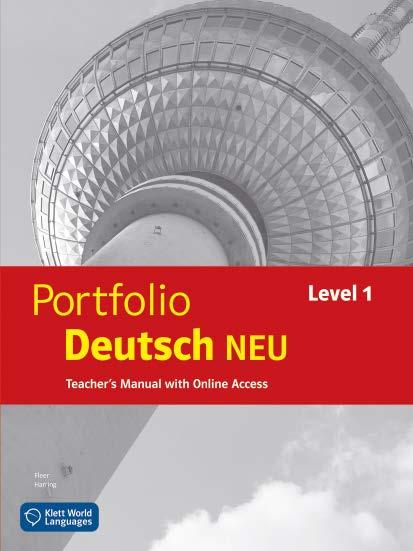


e





❯ AP and IB Correlations
Lesson plans
Worksheets
Cross-curricular Lessons
Glossaries and Vocabulary Lists
Transcripts
Answer keys
For additional details on our educational approach and the pedagogy that informs PORTFOLIO DEUTSCH NEU, please visit klettwl.com/pedagogy
For more information about Research & Validation, please visit klettwl.com/research-and-validation
